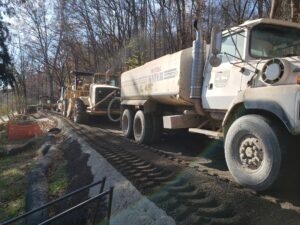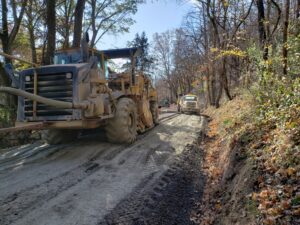MORGANTOWN — It’s early November and a mini-parade of heavy equipment is churning up Sellers Road in Tyler County.
The nearly 6.25-mile stretch running along Middle Island Creek near Middlebourne was widened and received a rebuilt base, new pavement, culverts and improved drainage, costing $7 million.
“Basically we’re building a whole new road,” said Shawn Bennett, road and special projects construction manager for Antero.
After the New Year, the road will host a full-size parade of oil and gas traffic to serve two Antero well pads: Roma Lou and Eldon.

The visit was the conclusion of a day viewing Antero road projects in Doddridge and Tyler counties.
Asked if he had a message for West Virginia residents, Bennett said, “If they would go around and look at any place that we’ve been, and have a little patience, we will always leave it better than what we found it.”
Anyone who has driven West Virginia’s shale country has seen the beat-up roads. Anyone who’s spent a day at the Capitol has heard complaints about the wear and tear.
Among our first stories on the fracking industry were visits in 2011 to Brock Ridge and Proctor Creek roads in the hills of Wetzel County. Proctor Creek was potholed and rutted while kidney-jarring Brock Ridge had no asphalt left (we’ll mention them again later).
But a hallway conversation with leaders of the Independent Oil and Gas Association–West Virginia during the 2019 legislative session led to this story: a new tour of shale roads to see what gas companies are doing these days to try to keep roads in shape.
Riding along with Bennett that November day was Anne Blankenship, executive director of the West Virginia Oil and Natural Gas Association, and two staffers with Charles Ryan Associates, which represents IOGA and WVONGA and helped set up the tour and field written questions.
 Bennett also drove us along the Oxford Road Upgrade, between Sunnyside and Taylor Drain roads in Doddridge County. This was a five-mile, $3.2 million combined effort between Antero and EQT. With Antero taking on 55% of the cost, EQT the rest.
Bennett also drove us along the Oxford Road Upgrade, between Sunnyside and Taylor Drain roads in Doddridge County. This was a five-mile, $3.2 million combined effort between Antero and EQT. With Antero taking on 55% of the cost, EQT the rest.
This is a busy area – 18 sites for Antero alone, and this particular stretch had numerous road base failures, Bennett said. The Antero/EQT contractor milled off 3 inches of the failing road and put down 7 new inches of asphalt. “It made for a nice project out here.”
The state agreed to take care of culverts and ditching, but on the day of the ride was running behind and had completed only half the ditching, he said. The poor draining also explain why the repair job was showing some signs of edge collapse at a few points along the way.
To determine what needs to be done to a stretch of road, Bennett said, Antero takes into account the number of well pads and the expected amount of traffic in the area. It does advance work, maintains it during the project, and completes any after-project repairs. Antero is responsible for the road until it’s released from its state Division of Highways bond.
Here’s what Antero has spent each year in upgrades, snow plowing, maintenance and flagging since 2015: 2015, $22,395,974; 2016, $21,389,936; 2017, $32,548,633; 2018, $30,794,236; 2019, $39,926,604.
Antero will generally present a proposal to the DOH for it to sign off on the engineering plans, he said. The state doesn’t always need to give its OK. But “we generally like to keep them as informed as we can and make sure that thy’re OK with what we plan to do.”

For any project, routine maintenance falls to the DOH, though will do ditching during the bond period, unless the state agrees otherwise, as with the Oxford project.
Often, several companies may be operating the dame area, all contributing to road wear, Bennett said. “That’s probably the biggest challenge we run into, is figuring out who’s responsible for what. There’s so many operators active on any given road.”
Some are mom and pops. “Usually the Anteros and the EQTs are the ones that end up footing the bill for the most part. It’s just hard to pinpoint.”
A frequent complaint voiced back in 2011, and after, could be summed up as “bad-neighbor policy.” Producers didn’t pay attention to local school and work schedules and jammed them at crucial times, hogged the roads and forced residents into ditches or onto shoulders, and more.
While Antero doesn’t have formal community meetings, Bennett said, it takes school bus and commuting schedules into account. Residents in tri-county area – Doddridge-Ritchie-Tyler – have the Antero number and can call with complaints and concerns. “Our public relations department has helped out tremendously with public relations and with our relationship with the state.”
Antero employees have GPS trackers in the vehicles and Antero encourages its contractors to do the same, to keep drivers accountable for their driving.
 One homeowner on the driving route had giant anti-EQT signs posted in the yard. Because of publication deadline, EQT was unable to meet for an interview but supplied a brief statement:
One homeowner on the driving route had giant anti-EQT signs posted in the yard. Because of publication deadline, EQT was unable to meet for an interview but supplied a brief statement:
“Because EQT values all of the communities where we operate, we know how important it is to manage any potential impacts to the roads in these areas. Our approach is to work with counties and municipalities in advance to proactively upgrade roads and ensure that they are suitable.
“In many cases, the roads we upgrade are improved compared to their condition before we started work. We don’t have many ongoing projects in West Virginia at the moment, but we will continue this proactive approach with any new operations. Our acreage and the communities where we operate in West Virginia are very important to EQT.”
WVONGA Q&A
Apart from the trip, WVONGA and The Dominion Post conducted a written Q&A about industry practices in general. Here are highlights.
Q: How do you evaluate if a road needs repair?
A: Road conditions are evaluated throughout all phases of well development. During the pre-construction phase, engineering consultants evaluate existing conditions to determine if roads will safely accommodate truck traffic. That process includes pavement sampling and surveying to determine lane width, turning radius and other safety issues. They also evaluate drainage. If it is determined that a road will not sufficiently handle traffic, companies will propose a road improvement project. Companies work with the WVDOH to secure agreements and approve plans.
“During a project, companies monitor conditions and conduct periodic repairs if needed. The WVDOH also monitors roads. Asphalt repairs are conducted when surface conditions require maintenance.
“In most instances, roads are in better condition than they were prior to the project due to the work the oil and natural gas companies perform before, during, and after their projects.”

Q: Do you find that road conditions are generally adequate when you begin a project?
A: “Primary and secondary routes are usually adequate to accommodate traffic. Deficiencies most often encountered on these routes include lack of adequate drainage, maintenance, and evidence of road slide activity.
“Companies often encounter roads lacking proper drainage. Freezing, thawing and heavy rainfall cause land to shift and slip over time. These types of issues are not due to the traffic from the oil and natural gas industry, but from lack of maintenance of the roads.”
Q: How much have companies invested?
A: “The oil and gas industry in West Virginia has invested more than $150 million to upgrade and maintain roads. It is likely that this number is much higher in reality. Investments made by individual companies are not reported and we can only provide the information voluntarily reported to WVONGA and IOGA.
“Chevron, for example, has invested $15 million on numerous county road improvement and repair projects in Marshall County. That includes more than seven miles of total road reconstruction, 12 road slide repairs (from weather and erosion) and basic repairs.
“Chevron and Williams, along with TransCanada, invested more than $6.5 million in the Fork Ridge Road project.”
Q: What kind of relationship does the industry have with local residents?
A: “The road projects provided are shining examples of how our industry proactively works to provide win-win-win outcomes for the communities in which we live and work.
“Williams, for example, believes in actively supporting the communities in which its employees live and business operates. Williams has invested $5 billion in West Virginia and has donated close to $1 million to the Upper Ohio Valley United Way. Its employees volunteer at local schools and support local non-profits through giving programs and volunteer activities.
Back to Wetzel
Last week, we revisited those roads we first rode along in 2011: Brock Ridge and Proctor Creek.
Proctor Creek, W.Va. 89, runs roughly east-west from U.S. 250 between New Martinsville and Hundred. Brock Ridge runs north-south between Proctor Creek and W.Va. 7 and served as a shortcut for Silver Hill residents going to New Martinsville.
In 2011, Proctor Creek between 250 and Brock Ridge was potholed and rutted and a family sedan could easily bottom out in many sections.
Brock Ridge, once paved, was virtually all gravel, and virtually impassable without a pickup or SUV. Even with the right vehicle, dodging the constant oil and gas traffic was a challenge and a CB radio was a useful tool to know what was coming ahead.
Chesapeake Energy was operating in the area then and talked about the challenges of maintaining Brock Ridge. It wasn’t designed for oil and gas traffic and lacked a proper base. Attempts to pave it failed.
Now, it’s paved. It has the occasional pothole. One spot on the southern side of the ridge, toward W.Va. 7, has a significant sinkhole in the northbound lane and requires coming to a near stop to creep through – or you can just pass it in the oncoming lane. A bit farther north, there’s a 10-yard stretch in the southbound lane that looks like the old road, with no asphalt at all. Here and there the edge is slipping away.
It’s paved, but it’s still not a speedway. It’s barely two lanes wide and full of curves and the occasional hairpin turn.
Proctor Creek is a bit worse. It’s not as bad as it was in 2011. You don’t have to keep stopping, slowing and veering between lanes. But there are potholes, dips and two sections with major slips that have closed the entire lane.
And posted frequently along both roads are blue and red signs offering landowners “top dollar” for mineral rights. They give a phone number and a web address to check out the offer.
Tweet David Beard @dbeardtdp Email dbeard@dominionpost.com




